List of birds of Madeira
This is a list of the bird species recorded in Madeira. The avifauna of Madeira include a total of 286 species, of which two are endemic, two have been introduced by humans and 203 are rare or accidental. The two listed species that are extinct and the one that is extirpated are not included in the species count. Eighteen species are globally threatened (twelve near-threatened, two vulnerable, three endangered and one critically endangered).
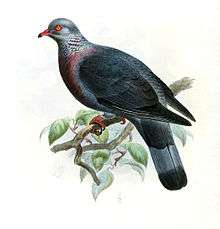
This list's taxonomic treatment (designation and sequence of orders, families and species) and nomenclature (common and scientific names) follow the conventions of The Clements Checklist of Birds of the World, 6th edition.[1] The family accounts at the beginning of each heading reflect this taxonomy, as do the species counts found in each family account. Introduced and accidental species are included in the total counts for Madeira.
The following tags have been used to highlight several categories. The commonly occurring native species do not fall into any of these categories.
- (A) Accidental - a species that rarely or accidentally occurs in Madeira
- (E) Endemic - a species endemic to Madeira
- (I) Introduced - a species introduced to Madeira as a consequence, direct or indirect, of human actions
- (Ex) Extirpated - a species that no longer occurs in Madeira although populations or other subspecies may exist elsewhere
- {Extinct} Extinct globally - a species that no longer exists
Ducks, geese, and waterfowl
Order: Anseriformes Family: Anatidae
Anatidae includes the ducks and most duck-like waterfowl, such as geese and swans. These birds are adapted to an aquatic existence with webbed feet, flattened bills, and feathers that are excellent at shedding water due to an oily coating.
- Graylag goose, Anser anser (A)
- Greater white-fronted goose, Anser albifrons (A)
- Taiga bean-goose, Anser fabalis (A)
- Pink-footed goose, Anser brachyrhynchus (A)
- Brant, Branta bernicla (A)
- Barnacle goose, Branta leucopsis (A)
- Canada goose, Branta canadensis (A)
- Mute swan, Cygnus olor
- Ruddy shelduck, Tadorna ferruginea (A)
- Common shelduck, Tadorna tadorna (A)
- Muscovy duck, Cairina moschata (I)
- Wood duck, Aix sponsa (A)
- Garganey, Spatula querquedula (A)
- Blue-winged teal, Spatula discors (A)
- Northern shoveler, Spatula clypeata (A)
- Gadwall, Mareca strepera (A)
- Eurasian wigeon, Mareca penelope (A)
- American wigeon, Mareca americana
- Mallard, Anas platyrhynchos
- Northern pintail, Anas acuta (A)
- Green-winged teal, Anas crecca
- Marbled teal, Marmaronetta angustirostris (A)
- Common pochard, Aythya ferina (A)
- Ring-necked duck, Aythya collaris (A)
- Tufted duck, Aythya fuligula (A)
- Greater scaup, Aythya marila (A)
- Surf scoter, Melanitta perspicillata (A)
- Common scoter, Melanitta nigra (A)
- Long-tailed duck, Clangula hyemalis (A)
- Bufflehead, Bucephala albeola (A)
- Common goldeneye, Bucephala clangula (A)
- Red-breasted merganser, Mergus serrator (A)
Pheasants, grouse, and allies
Order: Galliformes Family: Phasianidae
The Phasianidae are a family of terrestrial birds which consists of quails, partridges, snowcocks, francolins, spurfowls, tragopans, monals, pheasants, peafowls and jungle fowls. In general, they are plump (although they vary in size) and have broad, relatively short wings.
- Indian peafowl, Pavo cristatus (Ex)
- Common quail, Coturnix coturnix
- Red-legged partridge, Alectoris rufa (I)
- Ring-necked pheasant, Phasianus colchicus (I)
- Gray partridge, Perdix perdix (A)
Grebes
Order: Podicipediformes Family: Podicipedidae
Grebes are small to medium-large freshwater diving birds. They have lobed toes and are excellent swimmers and divers. However, they have their feet placed far back on the body, making them quite ungainly on land.
- Little grebe, Tachybaptus ruficollis (A)
- Pied-billed grebe, Podilymbus podiceps (A)
- Horned grebe, Podiceps auritus (A)
- Eared grebe, Podiceps nigricollis (A)
Pigeons and doves

Order: Columbiformes Family: Columbidae
Pigeons and doves are stout-bodied birds with short necks and short slender bills with a fleshy cere. The Madeiran wood pigeon (Columba palumbus maderensis), an endemic subspecies, is extinct.
- Rock pigeon, Columba livia
- Stock dove, Columba oenas (A)
- Common wood-pigeon, Columba palumbus (A)
- Trocaz pigeon, Columba trocaz (E)
- European turtle-dove, Streptopelia turtur
- Eurasian collared-dove, Streptopelia decaocto (I)
Bustards
Order: Otidiformes Family: Otididae
Bustards are large terrestrial birds mainly associated with dry open country and steppes in the Old World. They are omnivorous and nest on the ground. They walk steadily on strong legs and big toes, pecking for food as they go. They have long broad wings with "fingered" wingtips and striking patterns in flight. Many have interesting mating displays.
- Little bustard, Tetrax tetrax (A)
Cuckoos
Order: Cuculiformes Family: Cuculidae
The family Cuculidae includes cuckoos, roadrunners and anis. These birds are of variable size with slender bodies, long tails and strong legs. The Old World cuckoos are brood parasites.
- Great spotted cuckoo, Clamator glandarius (A)
- Common cuckoo, Cuculus canorus (A)
Nightjars and allies
Order: Caprimulgiformes Family: Caprimulgidae
Nightjars are medium-sized nocturnal birds that usually nest on the ground. They have long wings, short legs and very short bills. Most have small feet, of little use for walking, and long pointed wings. Their soft plumage is camouflaged to resemble bark or leaves.
- Common nighthawk, Chordeiles minor (A)
- Red-necked nightjar, Caprimulgus ruficollis (A)
- Eurasian nightjar, Caprimulgus europaeus (A)
Swifts
Order: Caprimulgiformes Family: Apodidae
Swifts are small birds which spend the majority of their lives flying. These birds have very short legs and never settle voluntarily on the ground, perching instead only on vertical surfaces. Many swifts have long swept-back wings which resemble a crescent or boomerang.
- Chimney swift, Chaetura pelagica (A)
- Alpine swift, Apus melba (A)
- Common swift, Apus apus
- Plain swift, Apus unicolor
- Pallid swift, Apus pallidus
- Little swift, Apus affinis (A)
- White-rumped swift, Apus caffer (A)
Rails, gallinules, and coots
_in_a_Nelumbo_nucifera_(Indian_Lotus)_pond_W_IMG_8779.jpg)
Order: Gruiformes Family: Rallidae
Rallidae is a large family of small to medium-sized birds which includes the rails, crakes, coots and gallinules. Typically they inhabit dense vegetation in damp environments near lakes, swamps or rivers. In general they are shy and secretive birds, making them difficult to observe. Most species have strong legs and long toes which are well adapted to soft uneven surfaces. They tend to have short, rounded wings and to be weak fliers.
- Water rail, Rallus aquaticus (A)
- Corn crake, Crex crex (A)
- Sora, Porzana carolina (A)
- Spotted crake, Porzana porzana (A)
- Lesser moorhen, Gallinula angulata (A)
- Eurasian moorhen, Gallinula chloropus
- Eurasian coot, Fulica atra
- American coot, Fulica americana (A)
- Allen's gallinule, Porphyrio alleni (A)
- Purple gallinule, Porphyrio martinicus (A)
- Western swamphen, Porphyrio porphyrio (A)
- Little crake, Zapornia parva (A)
- Baillon's crake, Zapornia pusilla (A)
Cranes
Order: Gruiformes Family: Gruidae
Cranes (Gruidae) are large, long-legged and long-necked birds. Unlike the similar-looking but unrelated herons, cranes fly with necks outstretched, not pulled back. Most have elaborate and noisy courting displays or "dances".
- Common crane, Grus grus (A)
Thick-knees
Order: Charadriiformes Family: Burhinidae
The thick-knees (Burhinidae) are a group of largely tropical waders in the family Burhinidae. They are found worldwide within the tropical zone, with some species also breeding in temperate Europe and Australia. They are medium to large waders with strong black or yellow-black bills, large yellow eyes and cryptic plumage. Despite being classed as waders, most species have a preference for arid or semi-arid habitats.
- Eurasian thick-knee, Burhinus oedicnemus (A)
Stilts and avocets
Order: Charadriiformes Family: Recurvirostridae
Recurvirostridae is a family of large wading birds, which includes the avocets and stilts. The avocets have long legs and long up-curved bills. The stilts have extremely long legs and long, thin, straight bills.
- Black-winged stilt, Himantopus himantopus (A)
- Pied avocet, Recurvirostra avosetta (A)
Oystercatchers
Order: Charadriiformes Family: Haematopodidae
The oystercatchers (Haematopodidae) are large and noisy plover-like birds, with strong bills used for smashing or prising open molluscs.
- Eurasian oystercatcher, Haematopus ostralegus (A)
- Canarian oystercatcher, Haematopus meadewaldoi (Extinct)
Plovers and lapwings
Order: Charadriiformes Family: Charadriidae
The family Charadriidae includes the plovers, dotterels and lapwings. They are small to medium-sized birds with compact bodies, short, thick necks and long, usually pointed, wings. They are found in open country worldwide, mostly in habitats near water.
- Black-bellied plover, Pluvialis squatarola (A)
- European golden-plover, Pluvialis apricaria (A)
- American golden-plover, Pluvialis dominica (A)
- Pacific golden-plover, Pluvialis fulva (A)
- Northern lapwing, Vanellus vanellus (A)
- Kentish plover, Charadrius alexandrinus
- Common ringed plover, Charadrius hiaticula (A)
- Little ringed plover, Charadrius dubius
- Killdeer, Charadrius vociferus (A)
- Eurasian dotterel, Charadrius morinellus (A)
Loons
Order: Galliformes Family: Gaviidae
The loons or divers are a group of aquatic birds found in many parts of North America and northern Eurasia (Europe, Asia and debatably Africa). All living species of loons are members of the genus (Gavia), family (Gaviidae) and order (Gaviiformes). There are 5 species worldwide and 1 species which occurs in Madeira.
- Common loon, Gavia immer (A)
Shearwaters and petrels
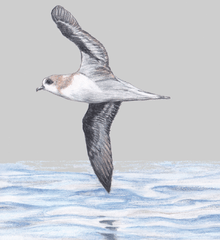
Order: Procellariiformes Family: Procellariidae
The procellariids are the main group of medium-sized "true petrels", characterised by united nostrils with medium septum and a long outer functional primary.
- Zino's petrel, Pterodroma madeira Endangered
- Desertas petrel, Pterodroma deserta Vulnerable
- Bulwer's petrel, Bulweria bulwerii
- Cory's shearwater, Calonectris borealis
- Scopoli's shearwater, Calonectris diomedea (A)
- Cape Verde shearwater, Calonectris edwardsii (A) Near-threatened
- Great shearwater, Ardenna gravis (A)
- Sooty shearwater, Ardenna griseus (A) Near-threatened
- Manx shearwater, Puffinus puffinus
- Balearic shearwater, Puffinus mauretanicus (A) Critically endangered
- Barolo shearwater, Puffinus baroli
Austral storm petrels
Order: Procellariiformes Family: Oceanitidae
The austral storm petrels are relatives of the petrels and are the smallest seabirds. They feed on planktonic crustaceans and small fish picked from the surface, typically while hovering. The flight is fluttering and sometimes bat-like.
- Wilson's storm petrel, Oceanites oceanicus
- White-faced storm petrel, Pelagodroma marina
Northern storm petrels
Order: Procellariiformes Family: Hydrobatidae
- European storm petrel, Hydrobates pelagicus
- Leach's storm petrel, Oceanodroma leucorhoa (A)
- Swinhoe's storm petrel, Oceanodroma monorhis (A)
- Band-rumped storm petrel, Oceanodroma castro
Tropicbirds
Order: Phaethontiformes Family: Phaethontidae
Tropicbirds are slender white birds of tropical oceans, with exceptionally long central tail feathers. Their heads and long wings have black markings. There are 3 species worldwide and 1 species which occurs in Madeira.
- Red-billed tropicbird, Phaethon aethereus (A)
Storks
Order: Ciconiiformes Family: Ciconiidae
Storks are large, long-legged, long-necked, wading birds with long, stout bills. Storks are mute, but bill-clattering is an important mode of communication at the nest. Their nests can be large and may be reused for many years. Many species are migratory. There are 19 species worldwide and 2 species which occur in Madeira.
- Black stork, Ciconia nigra (A)
- White stork, Ciconia ciconia (A)
Boobies and gannets
Order: Suliformes Family: Sulidae
The sulids comprise the gannets and boobies. Both groups are medium to large coastal seabirds that plunge-dive for fish. There are 9 species worldwide and 1 species which occurs in Madeira.
- Northern gannet, Morus bassanus (A)
Cormorants
Order: Suliformes Family: Phalacrocoracidae
Phalacrocoracidae is a family of medium to large coastal, fish-eating seabirds that includes cormorants and shags. Plumage colouration varies, with the majority having mainly dark plumage, some species being black-and-white and a few being colourful. There are 38 species worldwide and 2 species which occur in Madeira.
- Great cormorant, Phalacrocorax carbo (A)
- European shag, Phalacrocorax aristotelis (A)
Bitterns, herons and egrets
Order: Pelecaniformes Family: Ardeidae
The family Ardeidae contains the bitterns, herons and egrets. Herons and egrets are medium to large wading birds with long necks and legs. Bitterns tend to be shorter necked and more wary. Members of Ardeidae fly with their necks retracted, unlike other long-necked birds such as storks, ibises and spoonbills.
- Great bittern, Botaurus stellaris (A)
- Little bittern, Ixobrychus minutus (A)
- Grey heron, Ardea cinerea
- Purple heron, Ardea purpurea (A)
- Little egret, Egretta garzetta
- Cattle egret, Bubulcus ibis (A)
- Squacco heron, Ardeola ralloides (A)
- Black-crowned night heron, Nycticorax nycticorax (A)
Ibises and spoonbills
Order: Pelecaniformes Family: Threskiornithidae
Threskiornithidae is a family of large terrestrial and wading birds which includes the ibises and spoonbills. They have long, broad wings with 11 primary and about 20 secondary feathers. They are strong fliers and despite their size and weight, very capable soarers. There are 36 species worldwide and 2 species which occur in Madeira.
- Glossy ibis, Plegadis falcinellus (A)
- Eurasian spoonbill, Platalea leucorodia (A)
Osprey
Order: Accipitriformes Family: Pandionidae
The family Pandionidae contains only one species, the osprey. The osprey is a medium-large raptor and a specialist fish-eater with a worldwide distribution.
- Osprey, Pandion haliaetus (A)
Hawks, kites and eagles
Order: Accipitriformes Family: Accipitridae
Accipitridae is a family of birds of prey, which includes hawks, eagles, kites, harriers and Old World vultures. These birds have powerful hooked beaks for tearing flesh from their prey, strong legs, powerful talons and keen eyesight.
- European honey buzzard, Pernis apivorus (A)
- Red kite, Milvus milvus (A) Near-threatened
- Black kite, Milvus migrans (A)
- Egyptian vulture, Neophron percnopterus (A) Endangered
- Western marsh harrier, Circus aeruginosus (A)
- Montagu's harrier, Circus pygargus (A)
- Eurasian sparrowhawk, Accipiter nisus
- Common buzzard, Buteo buteo
- Long-legged buzzard, Buteo rufinus (A)
- Booted eagle, Hieraaetus pennatus (A)
Caracaras and falcons
_in_Kinnarsani_WS%2C_AP_W_IMG_6037.jpg)
Order: Falconiformes Family: Falconidae
Falconidae is a family of diurnal birds of prey. They differ from hawks, eagles and kites in that they kill with their beaks instead of their talons. There are 62 species worldwide and 8 species which occur in Madeira.
- Lesser kestrel, Falco naumanni (A) Vulnerable
- Eurasian kestrel, Falco tinnunculus
- Red-footed falcon, Falco vespertinus (A) Near-threatened
- Eleonora's falcon, Falco eleonorae (A)
- Merlin, Falco columbarius (A)
- Eurasian hobby, Falco subbuteo (A)
- Peregrine falcon, Falco peregrinus (A)
- Barbary falcon, Falco pelegrinoides (A)
Sandpipers and allies
Order: Charadriiformes Family: Scolopacidae
Scolopacidae is a large diverse family of small to medium-sized shorebirds including the sandpipers, curlews, godwits, shanks, tattlers, woodcocks, snipes, dowitchers and phalaropes. The majority of these species eat small invertebrates picked out of the mud or soil. Variation in length of legs and bills enables multiple species to feed in the same habitat, particularly on the coast, without direct competition for food.
- Common sandpiper, Actitis hypoleucos
- Spotted sandpiper, Actitis macularius (A)
- Green sandpiper, Tringa ochropus (A)
- Spotted redshank, Tringa erythropus (A)
- Common greenshank, Tringa nebularia (A)
- Lesser yellowlegs, Tringa flavipes (A)
- Wood sandpiper, Tringa glareola (A)
- Common redshank, Tringa totanus (A)
- Upland sandpiper, Bartramia longicauda (A)
- Whimbrel, Numenius phaeopus (A)
- Eurasian curlew, Numenius arquata (A) Near-threatened
- Black-tailed godwit, Limosa limosa (A) Near-threatened
- Bar-tailed godwit, Limosa lapponica (A)
- Ruddy turnstone, Arenaria interpres
- Red knot, Calidris canutus (A)
- Sanderling, Calidris alba (A)
- Semipalmated sandpiper, Calidris pusilla (A)
- Western sandpiper, Calidris mauri (A)
- Little stint, Calidris minuta (A)
- White-rumped sandpiper, Calidris fuscicollis (A)
- Pectoral sandpiper, Calidris melanotos (A)
- Purple sandpiper, Calidris maritima (A)
- Dunlin, Calidris alpina (A)
- Curlew sandpiper, Calidris ferruginea (A)
- Ruff, Calidris pugnax (A)
- Jack snipe, Lymnocryptes minimus (A)
- Great snipe, Gallinago media (A) Near-threatened
- Common snipe, Gallinago gallinago (A)
- Eurasian woodcock, Scolopax rusticola
- Wilson's phalarope, Phalaropus tricolor (A)
- Red-necked phalarope, Phalaropus lobatus (A)
- Red phalarope, Phalaropus fulicarius (A)
Pratincoles and coursers
Order: Charadriiformes Family: Glareolidae
Glareolidae is a family of wading birds comprising the pratincoles, which have short legs, long pointed wings and long forked tails, and the coursers, which have long legs, short wings and long, pointed bills which curve downwards. There are 2 species occur in Madeira.
- Cream-colored courser, Cursorius cursor (A)
- Collared pratincole, Glareola pratincola (A)
Gulls, terns, and skimmers
Order: Charadriiformes Family: Laridae
Laridae is a family of medium to large seabirds and includes gulls, terns, and skimmers. Gulls are typically grey or white, often with black markings on the head or wings. They have stout, longish bills and webbed feet. Terns are a group of generally medium to large seabirds typically with grey or white plumage, often with black markings on the head. Most terns hunt fish by diving but some pick insects off the surface of fresh water. Terns are generally long-lived birds, with several species known to live in excess of 30 years.
- Black-legged kittiwake, Rissa tridactyla (A)
- Sabine's gull, Xema sabini (A)
- Black-headed gull, Chroicocephalus ridibundus
- Little gull, Hydrocoloeus minutus (A)
- Franklin's gull, Leucophaeus pipixcan (A)
- Mediterranean gull, Ichthyaetus melanocephalus (A)
- Pallas's gull, Ichthyaetus ichthyaetus (A)
- Common gull, Larus canus (A)
- Ring-billed gull, Larus delawarensis (A)
- Herring gull, Larus argentatus (A)
- Yellow-legged gull, Larus michahellis
- Iceland gull, Larus glaucoides (A)
- Lesser black-backed gull, Larus fuscus
- Glaucous gull, Larus hyperboreus (A)
- Great black-backed gull, Larus marinus (A)
- Sooty tern, Onychoprion fuscatus (A)
- Little tern, Sternula albifrons (A)
- Gull-billed tern, Gelochelidon nilotica (A)
- Black tern, Chlidonias niger (A)
- White-winged tern, Chlidonias leucopterus (A)
- Whiskered tern, Chlidonias hybrida (A)
- Roseate tern, Sterna dougallii
- Common tern, Sterna hirundo
- Arctic tern, Sterna paradisaea (A)
- Sandwich tern, Thalasseus sandvicensis (A)
Skuas
Order: Charadriiformes Family: Stercorariidae
The family Stercorariidae are, in general, medium to large sea birds, typically with grey or brown plumage, often with white markings on the wings. They nest on the ground in temperate and arctic regions and are long-distance migrants. There are 7 species worldwide of which 4 species have been recorded off the coasts of Madeira.
- Great skua, Stercorarius skua (A)
- Pomarine jaeger, Stercorarius pomarinus (A)
- Parasitic jaeger, Stercorarius parasiticus (A)
- Long-tailed jaeger, Stercorarius longicaudus (A)
Auks
Order: Charadriiformes Family: Alcidae
Auks (Alcidae) are a family of seabirds which are superficially similar to penguins with their black-and-white colours, their upright posture and some of their habits but which are able to fly. There are about 23 species worldwide, of which 6 are recorded in Madeira.
- Dovekie, Alle alle (A)
- Atlantic puffin, Fratercula arctica (A)
Barn owls
Order: Strigiformes Family: Tytonidae
Barn owls are medium-sized to large owls with large heads and characteristic heart-shaped faces. They have long strong legs with powerful talons. There are about 16 species worldwide with 1 in Madeira.
- Barn owl, Tyto alba schmitzi (E)
Typical owls
Order: Strigiformes Family: Strigidae
Typical owls are small to large solitary nocturnal birds of prey. They have large forward-facing eyes and ears, a hawk-like beak and a conspicuous circle of feathers around each eye called a facial disc. There are about 199 species worldwide, of which 2 have been recorded in Madeira. There is also one endemic species, known only from fossil remains, that probably became extinct following human settlement of the island.
- Eurasian scops owl, Otus scops (A)
- Madeiran scops owl, Otus mauli (Extinct)
- Short-eared owl, Asio flammeus (A)
Kingfishers
Order: Coraciiformes Family: Alcedinidae
Kingfishers are medium-sized birds with large heads, long, pointed bills, short legs and stubby tails. There are 93 species worldwide and 1 species which occurs in Madeira.
- Common kingfisher, Alcedo atthis (A)
Bee-eaters
Order: Coraciiformes Family: Meropidae
The bee-eaters are a group of near passerine birds in the family Meropidae. Most species are found in Africa but others occur in southern Europe, Madagascar, Australia and New Guinea. They are characterised by richly coloured plumage, slender bodies and usually elongated central tail feathers. All are colourful and have long downturned bills and pointed wings, which give them a swallow-like appearance when seen from afar. There are 26 species worldwide, 1 of which occurs in Madeira.
- European bee-eater, Merops apiaster (A)
Typical rollers
Order: Coraciiformes Family: Coraciidae
Rollers resemble crows in size and build, but are more closely related to the kingfishers and bee-eaters. They share the colourful appearance of those groups with blues and browns predominating. The two inner front toes are connected, but the outer toe is not. There are 12 species worldwide of which 1 species occurs in Madeira.
- European roller, Coracias garrulus (A) Near-threatened
Hoopoes
Order: Coraciiformes Family: Upupidae
Hoopoes have black, white and orangey-pink colouring with a large erectile crest on their head. There are 2 species worldwide, 1 of which occurs in Madeira.
- Eurasian hoopoe, Upupa epops
Woodpeckers
Order: Piciformes Family: Picidae
Woodpeckers are small to medium-sized birds with chisel-like beaks, short legs, stiff tails and long tongues used for capturing insects. Some species have feet with two toes pointing forward and two backward, while several species have only three toes. Many woodpeckers have the habit of tapping noisily on tree trunks with their beaks.
- Eurasian wryneck, Jynx torquilla (A)
Shrikes
Order: Passeriformes Family: Laniidae
Shrikes are passerine birds known for their habit of catching other birds and small animals and impaling the uneaten portions of their bodies on thorns. A typical shrike's beak is hooked, like a bird of prey. There are 31 species worldwide, 2 of which occur in Madeira.
- Red-backed shrike, Lanius collurio (A)
- Woodchat shrike, Lanius senator (A)
Old-World orioles
Order: Passeriformes Family: Oriolidae
The Old World orioles are colourful medium-sized passerine birds. The beak is slightly curved and hooked, and, except in the figbirds, as long as the head. The plumage of most species is bright and showy, although the females often have duller plumage than the males. They are not related to the New World orioles. There are 29 species worldwide of which 1 species occurs in Madeira.
- Eurasian golden oriole, Oriolus oriolus (A)
Crows
Order: Passeriformes Family: Corvidae
The family Corvidae includes crows, ravens, jays, choughs, magpies, treepies, nutcrackers and ground jays. Corvids are above average in size among the Passeriformes, and some of the larger species show high levels of intelligence. There are 120 species worldwide of which 3 species occur in Madeira.
- Eurasian jackdaw, Corvus monedula (A)
- Rook, Corvus frugilegus (A)
- Common raven, Corvus corax (A)
Larks
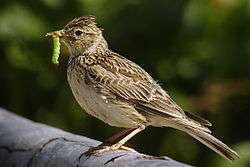
Order: Passeriformes Family: Alaudidae
Larks are small terrestrial birds with often extravagant songs and display flights. Most larks are fairly dull in appearance. Their food is insects and seeds. There are 91 species worldwide of which 3 species occur in Madeira.
- Calandra lark, Melanocorypha calandra (A)
- Greater short-toed lark, Calandrella brachydactyla (A)
- Sky lark, Alauda arvensis (A)
Swallows and martins
Order: Passeriformes Family: Hirundinidae
The family Hirundinidae is adapted to aerial feeding. They have a slender streamlined body, long pointed wings and a short bill with a wide gape. The feet are adapted to perching rather than walking, and the front toes are partially joined at the base. There are 75 species worldwide, 6 of which have been recorded in Madeira.
- Sand martin, Riparia riparia (A)
- Eurasian crag martin, Ptyonoprogne rupestris (A)
- Barn swallow, Hirundo rustica (A)
- Red-rumped swallow, Cecropis daurica (A)
- American cliff swallow, Petrochelidon pyrrhonota (A)
- Common house martin, Delichon urbicum (A)
Wrens
Order: Passeriformes Family: Troglodytidae
The wrens are mainly small and inconspicuous except for their loud songs. These birds have short wings and thin down-turned bills. Several species often hold their tails upright. All are insectivorous.
- Eurasian wren, Troglodytes troglodytes (A)
Kinglets
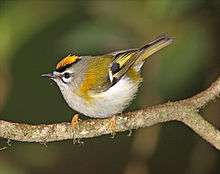
Order: Passeriformes Family: Regulidae
The kinglets, also called crests, are a small group of birds often included in the Old World warblers, but frequently given family status because they also resemble the titmice.
- Madeira firecrest, Regulus madeirensis (E)
Phylloscopidae
Order: Passeriformes Family: Phylloscopidae
Phylloscopidae is a newly described family of small insectivorous birds formerly placed in the Old World warbler family. Its members occur in Eurasia, ranging into Wallacea and Africa (and the Arctic warbler breeding east into Alaska). Most live in forest and scrub and frequently catch food on the wing. There are 75 species worldwide, 5 of which occur in Madeira.
- Willow warbler, Phylloscopus trochilus (A)
- Common chiffchaff, Phylloscopus collybita (A)
- Wood warbler, Phylloscopus sibilatrix (A)
- Yellow-browed warbler, Phylloscopus inornatus (A)
- Greenish warbler, Phylloscopus trochiloides (A)
Acrocephalidae
Order: Passeriformes Family: Acrocephalidae
Acrocephalidae (the marsh- and tree-warblers or acrocephalid warblers) is a family of oscine passerine birds, in the superfamily Sylvioidea. Most species are rather plain olivaceous brown above with much yellow to beige below. They are usually found in open woodland, reedbeds or tall grass. There are 55 species worldwide, 7 of which occur in Madeira.
- Western olivaceous warbler, Iduna opaca (A)
- Melodious warbler, Hippolais polyglotta (A)
- Icterine warbler, Hippolais icterina (A)
- Sedge warbler, Acrocephalus schoenobaenus (A)
- Eurasian reed warbler, Acrocephalus scirpaceus (A)
- Marsh warbler, Acrocephalus palustris (A)
- Great reed warbler, Acrocephalus arundinaceus (A)
Locustellidae
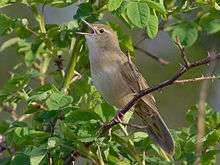
Order: Passeriformes Family: Locustellidae
Locustellidae is a newly recognized family of small insectivorous songbirds ("warblers"), formerly placed in the Old World warbler family. It contains the grass-warblers, grassbirds, and the Bradypterus "bush-warblers". The species are smallish birds with tails that are usually long and pointed. Most live in scrubland and frequently hunt food by clambering through thick tangled growth or pursuing it on the ground. There are 55 species worldwide, 2 of which occur in Madeira.
- Common grasshopper warbler, Locustella naevia (A)
- Eurasian river warbler, Locustella fluviatilis (A)
Old World warblers
Order: Passeriformes Family: Sylviidae
The family Sylviidae is a group of small insectivorous passerine birds. They mainly occur as breeding species, as the common name implies, in Europe, Asia and, to a lesser extent, Africa. Most are of generally undistinguished appearance, but many have distinctive songs. There are 75 species worldwide,[1] of which 8 species occur in Madeira.
- Eurasian blackcap, Sylvia atricapilla
- Garden warbler, Sylvia borin (A)
- Western Orphean warbler, Sylvia hortensis (A)
- Greater whitethroat, Sylvia communis (A)
- Lesser whitethroat, Sylvia curruca (A)
- Spectacled warbler, Sylvia conspicillata
- Subalpine warbler, Sylvia cantillans (A)
- Sardinian warbler, Sylvia melanocephala (A)
Old World flycatchers
Order: Passeriformes Family: Muscicapidae
Old World flycatchers are a large group of small passerine birds native to the Old World. They are mainly small arboreal insectivores. The appearance of these birds is highly varied, but they mostly have weak songs and harsh calls. There 274 species worldwide and 14 species which occur in Madeira.
- Spotted flycatcher, Muscicapa striata (A)
- Rufous-tailed scrub-robin, Cercotrichas galactotes (A)
- European robin, Erithacus rubecula
- Common nightingale, Luscinia megarhynchos (A)
- European pied flycatcher, Ficedula hypoleuca (A)
- Red-breasted flycatcher, Ficedula parva (A)
- Common redstart, Phoenicurus phoenicurus (A)
- Black redstart, Phoenicurus ochruros (A)
- Rufous-tailed rock-thrush, Monticola saxatilis (A)
- Whinchat, Saxicola rubetra (A)
- African stonechat, Saxicola torquatus (A)
- Northern wheatear, Oenanthe oenanthe (A)
- Desert wheatear, Oenanthe deserti (A)
- Isabelline wheatear, Oenanthe isabellina (A)
Thrushes and allies
Order: Passeriformes Family: Turdidae
The thrushes are a group of passerine birds that occur mainly in the Old World. They are plump, soft plumaged, small to medium-sized insectivores or sometimes omnivores, often feeding on the ground. Many have attractive songs. There are 335 species worldwide and 7 species which occur in Madeira.
- Wood thrush, Hylocichla mustelina (A)
- Ring ouzel, Turdus torquatus (A)
- Eurasian blackbird, Turdus merula
- Fieldfare, Turdus pilaris (A)
- Redwing, Turdus iliacus (A)
- Song thrush, Turdus philomelos (A)
- Mistle thrush, Turdus viscivorus (A)
Starlings
Order: Passeriformes Family: Sturnidae
Starlings are small to medium-sized passerine birds. Their flight is strong and direct and they are very gregarious. Their preferred habitat is fairly open country. They eat insects and fruit. Plumage is typically dark with a metallic sheen. There are 125 species worldwide and 3 species which occur in Madeira.
- Rosy starling, Pastor roseus (A)
- European starling, Sturnus vulgaris (A)
- Spotless starling, Sturnus unicolor (A)
Wagtails and pipits
Order: Passeriformes Family: Motacillidae
Motacillidae is a family of small passerine birds with medium to long tails. They include the wagtails, longclaws and pipits. They are slender, ground feeding insectivores of open country.
- Western yellow wagtail, Motacilla flava (A)
- Citrine wagtail, Motacilla citreola (A)
- Grey wagtail, Motacilla cinerea
- White wagtail, Motacilla alba (A)
- Richard's pipit, Anthus richardi (A)
- Tawny pipit, Anthus campestris (A)
- Berthelot's pipit, Anthus berthelotii
- Meadow pipit, Anthus pratensis (A)
- Tree pipit, Anthus trivialis (A)
- Red-throated pipit, Anthus cervinus (A)
- Rock pipit, Anthus petrosus (A)
Calcariidae
Order: Passeriformes Family: Calcariidae
The Calcariidae are a small family of passerine birds. There are 6 species worldwide and 1 species which occurs in Madeira.
- Snow bunting, Plectrophenax nivalis (A)
New World warblers
Order: Passeriformes Family: Parulidae
A group of small, often colourful passerine birds restricted to the New World. Most are arboreal and insectivorous. There are about 118 species worldwide, 2 of which occur as vagrants in Madeira.
- American redstart, Setophaga ruticilla (A)
- Yellow warbler, Setophaga petechia (A)
Buntings
Order: Passeriformes Family: Emberizidae
The emberizids are a family of passerine birds. They are seed-eating birds with distinctively shaped bills. There are 9 species worldwide[1] of which 1 species occurs in Madeira.
- Ortolan bunting, Emberiza hortulana (A)
Finches
Order: Passeriformes Family: Fringillidae
Finches are seed-eating passerine birds, that are small to moderately large and have a strong beak, usually conical and in some species very large. All have twelve tail feathers and nine primaries. These birds have a bouncing flight with alternating bouts of flapping and gliding on closed wings, and most sing well. There are 137 species worldwide of which 11 species occur in Madeira.
- Common chaffinch, Fringilla coelebs
- Brambling, Fringilla montifringilla (A)
- European greenfinch, Chloris chloris
- Parrot crossbill, Loxia pytyopsittacus
- Red crossbill, Loxia curvirostra (A)
- Eurasian siskin, Spinus spinus (A)
- European goldfinch, Carduelis carduelis
- Common linnet, Linaria cannabina
- European serin, Serinus serinus (A)
- Island canary, Serinus canaria
- Hawfinch, Coccothraustes coccothraustes (A)
Sparrows
Order: Passeriformes Family: Passeridae
Sparrows are small passerine birds. In general, sparrows tend to be small, plump, brown or grey birds with short tails and short powerful beaks. Sparrows are seed eaters, but they also consume small insects.
- Spanish sparrow, Passer hispaniolensis
- Rock sparrow, Petronia petronia
Waxbills and allies
Order: Passeriformes Family: Estrildidae
The estrildid finches are small passerine birds of the Old World tropics and Australasia. They are gregarious and often colonial seed eaters with short thick but pointed bills. They are all similar in structure and habits, but have wide variation in plumage colours and patterns. There are 141 species worldwide, 1 of which occurs in Madeira.
- Common waxbill, Estrilda astrild (I)
See also
References
- Clements, J.F.; Schulenberg, T.S.; Iliff, M.J.; Sullivan, B.L.; Wood, C.L. (2010). "The Clements Checklist of Birds of the World, Version 6.5" (xls). Cornell University Press. Retrieved 25 September 2011.
External links

- Avibase - Bird Checklists of the World: Portugal.
- Avibase - Bird Checklists of the World: Azores.
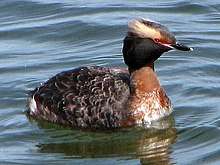
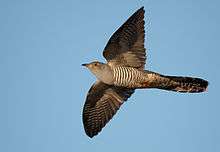

.jpg)

.jpg)
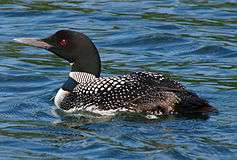
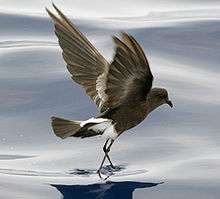
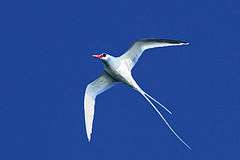

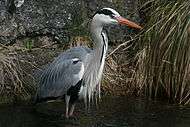




.jpg)
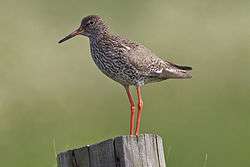
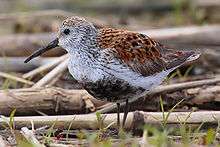
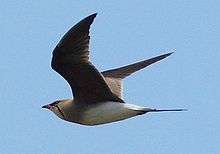
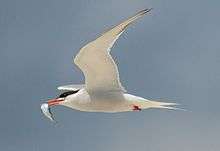

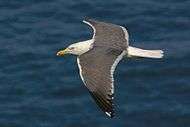

_(1).jpg)
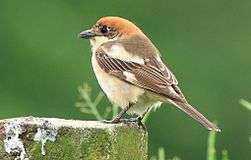
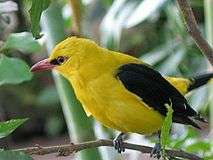
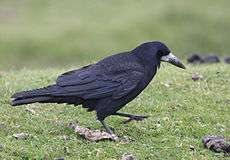
.jpg)
.jpg)
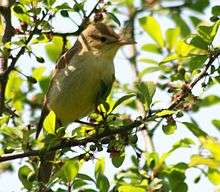

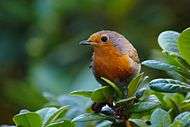
.jpg)
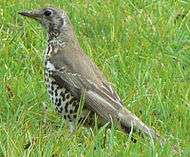

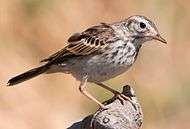
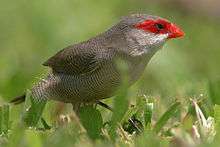
.png)